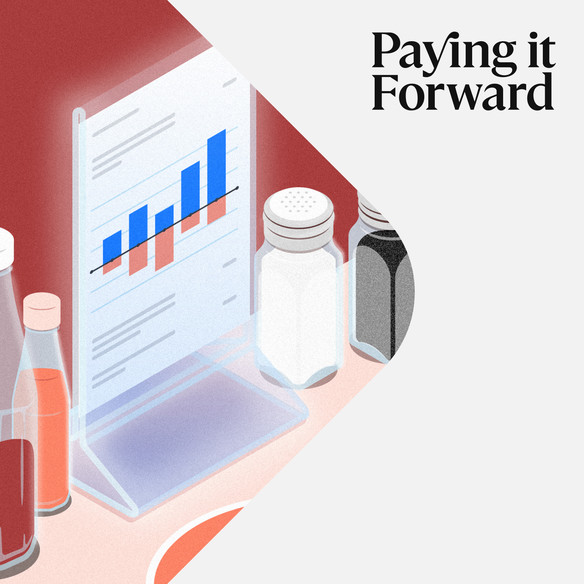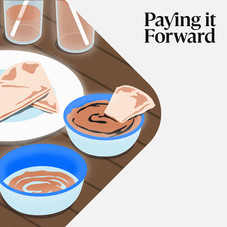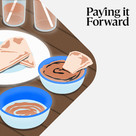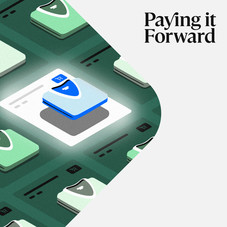Table of contents
Black & Caspian is a Mediterranean restaurant based in Chicago, Illinois, that opened its doors in 2020.
Co-owner Leyla Khanahmad says they were so focused on the day-to-day operations after launching at the start of the pandemic that they weren’t able to analyze their performance. “I think that for the past few months we have really started paying attention to our numbers, even on a daily basis and then we look at our numbers on a bi-weekly basis and we do monthly analysis.“ said Khanahmad.
Looking at those numbers led them to ending weekend brunch and focusing more on the wine aspect of their wine and bistro restaurant.
“My partner was very, very, very worried about it because he thought it was kind of a fail for us. At the same time, finances get personal when you have a small business so that line of whether that makes sense financially or whether that makes sense personally … those lines get sometimes get blurred,” said Khanahmad.
Bench Accounting Lead Client Associate Ellen Cornish says that maintaining a regularly reviewed profit and loss, balance sheet and cash flow statement can help small business owners stay on top of their bookkeeping.
“If you’re ever struggling or unsure, I would get on top of that first and foremost,’ said Cornish. “If it’s incomplete, there’s a big chance there is a gap that you are missing in your understanding of how your business operates and functions. Without that, you really can’t go in any direction without knowing for sure that it’s the right course of action or the most efficient use of you and your business’ time.”
A little about this episode on profit and loss…
In our fifth episode of Paying It Forward, hear from Bench Accounting Lead Associate Ellen Cornish on the financial statements that give you the best look at your business’s financial health. Then you’ll hear how Black & Caspian’s Leyla Khanahmad started measuring her business’s profit and loss, something that would turn out to be a gateway to better managing cash flow for the business as a whole.
When it comes to running a small business, tackling financial decisions can be daunting and often overwhelming. Each week on Paying it Forward, we’ll focus on a common financial issue bringing in an expert in the field with actionable insights and a fellow business owner who has tackled it firsthand.
Guests
- Leyla Khanahmad, co-owner of Black & Caspian, a Mediterranean restaurant and wine bar based in Chicago, Illinois
- Ellen Cornish, Lead Client Associate of Bench Accounting, a professional bookkeeping service for small businesses in Vancouver, Canada
More resources
- Read: Three Accounting Reports You Should Be Keeping
- Read: 4 Common Financial Issues Small Businesses Face
- Try: Profit and Loss Statement – Downloadable Tool
- Try: Cash Flow Management for Small Business Owners – Template
Full transcript:
You’re listening to Paying it Forward, a Square Podcast. When it comes to running a small business, tackling financial decisions can be daunting and often overwhelming. Each week we tackle one issue that could affect your business’ cash flow and hear from a fellow business owner experiencing it first hand.
On today’s episode, we look at profit and loss. What are the key financial statements small businesses should keep track of to stay on top of their financial health? By keeping an eye on cash inflows and outflows, you can better manage your cashflow as you grow.
Ellen: So a profit and loss statement is defined as a type of financial report that tells you how profitable your business was over a given period. It shows your revenue minus your losses and expenses. The result of this is either your final profit or your final loss. The profit and loss statement is one of the three most important financial statements for business owners alongside the balance sheet and the cashflow statement.
That’s Ellen Cornish, Lead Client Research Associate at Bench Accounting, a professional bookkeeping service for small businesses.
Ellen: One of the most common reasons small businesses start producing profit and loss statements is to show banks and investors how profitable their business is. When profit and loss statements are meant to be shared outside of business, they are normally called income statements. A profit and loss statement is for internal use. Only other than that, those two statements are essentially the same.
A balance sheet gives a snapshot of your financials at a particular moment, incorporating every journal entry since your company launched. It shows what your business owns in assets. It shows what your business owes in liabilities, as well as what money is left over for owners, which is the owner’s equity. Because it summarizes a business’s finances, the balance sheet is also sometimes called the statement of financial position.
Companies usually prepare one at the very end a reporting period, such as a month, quarter, or year. Income statements, or profit and loss statements, and balance sheets, they do play a part in cashflow in forecasting it. Cashflow forecasting is really similar to budgeting, but instead of estimating revenues and expenses, it estimates cash coming in and cash going out of the business. Cashflow forecasting or cashflow statements itself, can’t be generated without information that comes from both the profit and loss and the balance sheet.
Here’s some advice she shares if you’re trying to better manage your cashflow.
Ellen: If you’re ever struggling or unsure, I would get on top of that first and foremost. If it’s incomplete, there’s a big chance there is a gap that you are missing in your understanding of how your business operates and functions. Without that, you really can’t go in any direction or next steps without knowing for sure that it’s the right course of action or the most efficient use of you and your business’s time. Maintain — but also regularly review — your profit and loss, balance sheet, and cashflow statements, which means staying on top of all of your record keeping and bookkeeping. And I say that because I definitely get the sense that a lot of business owners are struggling and they know that cashflow is a problem, but they don’t really know where it is a problem. And I find that reviewing these forms regularly gives you that insight to actually understand a lot better.
You’re trying new ways to sell, making tough financial decisions, doing what it takes to make your business succeed. You aren’t alone. Join us on Square’s Talking Squarely podcast, where independent business owners just like you get real about the ups and downs of running a business. Listen and subscribe to Talking Squarely.
Our guest today is Leyla Khanahmad, co-owner of Black & Caspian Mediterranean restaurant in Chicago, Illinois. This year in business has taught her how to go from thinking about finances in the short term to a more long-term outlook. She says they have gone from planning for the business on a day-to-day or week-to-week basis to thinking like bigger businesses. She hopes this shift in perspective will help their restaurant scale just like them.
Leyla: I opened Black & Caspian with my partner Ahmet. He is our chef right now. We opened in January 2020. And that was right before the pandemic hit. And we were shut down for three months right after that. So we’ve been in business for a little over a year now. It was a funny story. When we first started thinking about opening a wine bistro, I still had a job at CIBC. I worked as a business development coordinator in private wealth management, and I was so terrified of taking the leap, taking this risk. We opened the restaurant and for two weeks I was still going to work and coming to the restaurant after work.
Even though quitting her job felt like a big leap at the time, she says the risk was worth the reward.
Leyla: When you start the business, you get over enthusiastic and you’re overly ambitious about all the things that you want to do. So instead of setting a budget aside and instead of really paying attention to your numbers and performance and the history, you’re only focusing on growth and you are over-investing in certain decisions. And when something like the pandemic or something extraordinary happens, you are left in a situation where you’re unable to fulfill all the risks that you take. But at the same time, you’re unable to take a step back. Owning a restaurant when planning long term — it’s best to take small steps, small risks, and not to be overly ambitious in your beginnings instead of taking huge steps that might leave you with nothing at the end of the day. The very first time that we got shut down, I think it was March 16.
We really sat down and questioned the way we ran our business because there were two weeks ahead of us that we were going to be out of business. We were forced to shut the business down and we were so terrified. And it’s just two weeks. If you really think about it, it’s not really that big of a timeframe for a small business, but we were terrified because we had nothing planned for a situation like that. And that’s when we started thinking, okay, what do we do to prepare for unforeseen situations like that? So that’s when we started diving into the Square dashboard, the history, the performance, the numbers, the percentages, and tracking our performance, making difficult decisions such as should we have weekend brunch or shouldn’t we? Does it make financial sense to have it or not?
When the city shut down, Leyla and her partner started taking a closer look at their finances. What could they sacrifice to ensure their business would be resilient through the pandemic?
Leyla: So our restaurant is located in Lakeview East, and we are on Broadway and Surf in that neighborhood. All the restaurants that are in that neighborhood, they do brunch and brunch for us was more of an emotional decision that we took. But at the same time, we were very enthusiastic about it, thinking that we were going to be able to perform well. We really did brunch for about a year without ever sitting down and looking at our numbers and seeing how much money we made from dinner. And how much money have you made from brunch. We were so overwhelmed with the day to day that we failed to even analyze our performance. The first signal was when staff was getting burned out because on Friday night it gets busy and then everybody works from Friday night to Saturday morning. That’s a 15-hour shift on Saturday and then 15 hour shift on Sunday.
So that was the first red flag where we were like, okay, so our performance is going down because staff is getting burnt out. And then that’s when we opened Square and we started looking at our numbers and there was such a shocking result on Square for us when we saw the numbers, we were like, okay, we’re not doing brunch anymore because first of all, financially, it doesn’t make sense. And it’s hurting our performance, our staff in the long term.
We’d rather niche down, be like a dinner, wine house, a wine bistro restaurant rather than spread out our attention, resources, and energy on to too many things that we cannot afford to put on our plate anymore. I think that for the past few months, we have really started paying attention to our numbers, even on a daily basis. And then we look at our numbers on a bi-weekly basis. And then we do a monthly analysis. The decision of walking away from brunch was really … my partner was very, very worried about it because he thought that this was kind of a fail for us. But at the same time finance gets personal when you have a small business. So that line of whether that makes sense financially or whether that makes sense personally, those lines sometimes get blurred and you have to set the right boundaries. And you have to know when to say no to yourself so that your business it does well.
Although it was a difficult decision to make, cutting brunch paid off. And by taking a closer look at their margins, they were able to focus on what made the most sense for their business going forward.
Leyla: We are now working on opening a cheese and wine bar, a second location. And I think that now that we know how the business works with wine and cocktails and the liquor license being in it, there’s just very little uncertainty and with little uncertainty the risks are lowered and we know approximately what to expect. For example, we have the lamb chops, we have the marble steak, we have the lamb shank, those dishes are very expensive to make. And the profit margin from those dishes is like, it’s a funny figure, but that’s where we were able to come in with wine and with cocktails and with things that were going to compensate for the difficult decision of keeping those on the menu. There’s that moment, every single day we look at the numbers and we’re like okay, this dish is just killing us, but we have to keep it on the menu.
Especially during the pandemic, those first three months were really, really scary. We did really well in January and February, although we were in new business. It was just, things were going really, really well, especially until mid-March, but then everything got cut off. So we had to slow down, take a step back. We have to keep our costs very, very low. Even if we were going to perform well, we should not lose track of our spendings. That’s the thought process that we’re going to apply to Black & Barrel — the name of the second location, by the way.
Cutting back on certain services and items, as well as choosing where to reinvest next aren’t the only decisions that led Leyla and Ahmet to the second location they’re planning today. They were able to create new revenue streams during the shutdown that helped them make the most of their produce.
Leyla: First, they said that we were going to be closed for two weeks. Then it became one month. Then it became three months. That’s when we really started thinking about diversifying our revenue streams, but in a way that it is not just an emotional decision that they’re making, but something that impacts the restaurant positively in a sense that, for example, it decreases food waste at the same time, it increases customer loyalty and all that.
And so we came up with this idea that restaurants can deliver meal kits like ingredients and recipes, and it could be a one-off order without anyone having to commit to a weekly or a monthly meal plan. They don’t have to schedule it. They can just go online, order the meal kit and have it delivered to them. So we built our basic MVP for that idea, and we actually made it to round four at Techstars Chicago Accelerator this year. And that is something that we thought would benefit a lot of the restaurants. So that’s something that we’re working on right now. And we are onboarding more and more restaurants adding more meal kits onto the platform. And we are hoping to launch that as soon as next fall. We knew right off the bat that it’s a huge challenge to make money off of food. Food is expensive, it’s perishable. It’s very difficult to track everything in a way that you end up with the right numbers at the end of day.
For small business owners just starting out, Leyla gives this advice.
Leyla: I would say, even if you have the money you should still consider putting in at only 25% of the money into the opening process. For example, with Black & Caspian, when I first walked into this restaurant, I walked in, I really liked the location. I liked everything about it, like the size of the kitchen and everything. I knew he had a liquor license. I walked in and I said, “Hey, are you selling?” And he said, “Yes. You know, I have been here for 10 years. I’m burnt out. I want to get rid of it. I’m selling for $75,000.” And obviously it was a lot of money. I went back to him six times and he brought it down to $25,000. And sometimes you do get business owners that are willing to sell. You just need to negotiate a little bit. So I let him, for example, take all of his furniture that he could sell.
I let him take his ice machine with him. I just negotiated it in a way that he agreed to sell it to me for $25,000. And this included the kitchen equipment, the licenses, and everything. And I was also able to negotiate paying him in installments. So I asked him to stay in until I brought in the entire full amount. So it’s just important to be open to that negotiation. Of course, Ahmet and I could have just gone out into the industry, worked for five years, saved up more money. But then, by that time, the industry would have changed, the prices, the rent, everything would have changed, right? So we chose to negotiate instead and take the leap. The best way to search is to go into a neighborhood, see a restaurant that you like, literally walk in, and ask the owners if they’re selling, how much they’re paying, what their business model looks like. And a lot of the business owners are open to that.
In the end, Leyla says that despite going to school for hospitality, she learned the most through firsthand experience, failing, and succeeding by trying everything herself.
Leyla: I came from a very different culture into a totally different culture, especially when it comes to food. I think that the U.S. works very, very differently. Every state, every city, every food type, works very, very differently. But I think that it’s important to be part of this industry before you jump onto something like that. I worked at an Italian restaurant and I worked in service, I worked in the kitchen. And I saw the reality of running a business here in the U.S. It’s important to be prepared to be the everything person, because the owner is almost always the operator. You’re always going to be in operations and you have to be prepared for anything and everything, for staff not showing up for work, for your landlord going crazy with rent, very weird customer feedback that you never expected. And I think being the everything person is key here, and staying humble, especially during the times when you do well.
Thank you to Ellen Cornish and Leyla Khanahmad for their thoughts on payroll. Ellen Cornish is Lead Client Research Associate for Bench, America’s largest professional bookkeeping service for small businesses.
Leyla Khanahmad is co-owner of Black & Caspian. Check them out on Facebook and Instagram at blackandcaspian or their website, blackcaspian.com. If you’re in the Chicago area, Leyla says, come on by for live music any night of the week. For more information on tools like the ones we discussed on today’s episode, head to squareup.com/us/en/townsquare, download free templates for profit and loss statements, cashflow forecasting, and more.
__You’ve been listening to Paying it Forward, a Square production. This episode was produced by Deborah Findling, Camille Kail, and Clara Shannon. Our music was composed by Jordain Wallace with sound recording by Sorrentino Media and D.R Baker. Thanks for listening. __
![]()



![Profit and Loss Statement [Downloadable Tool]](https://images-cdn2.welcomesoftware.com/Zz0zYjI0OTQ4Y2Q4YmMxMWVkYmZlOTRlYTUyMmRiOGY0NQ==?width=272&height=272)








